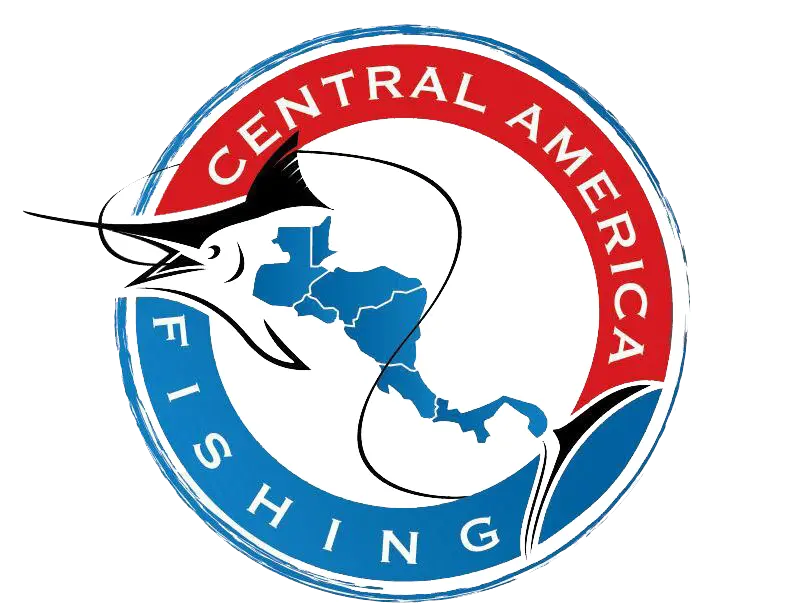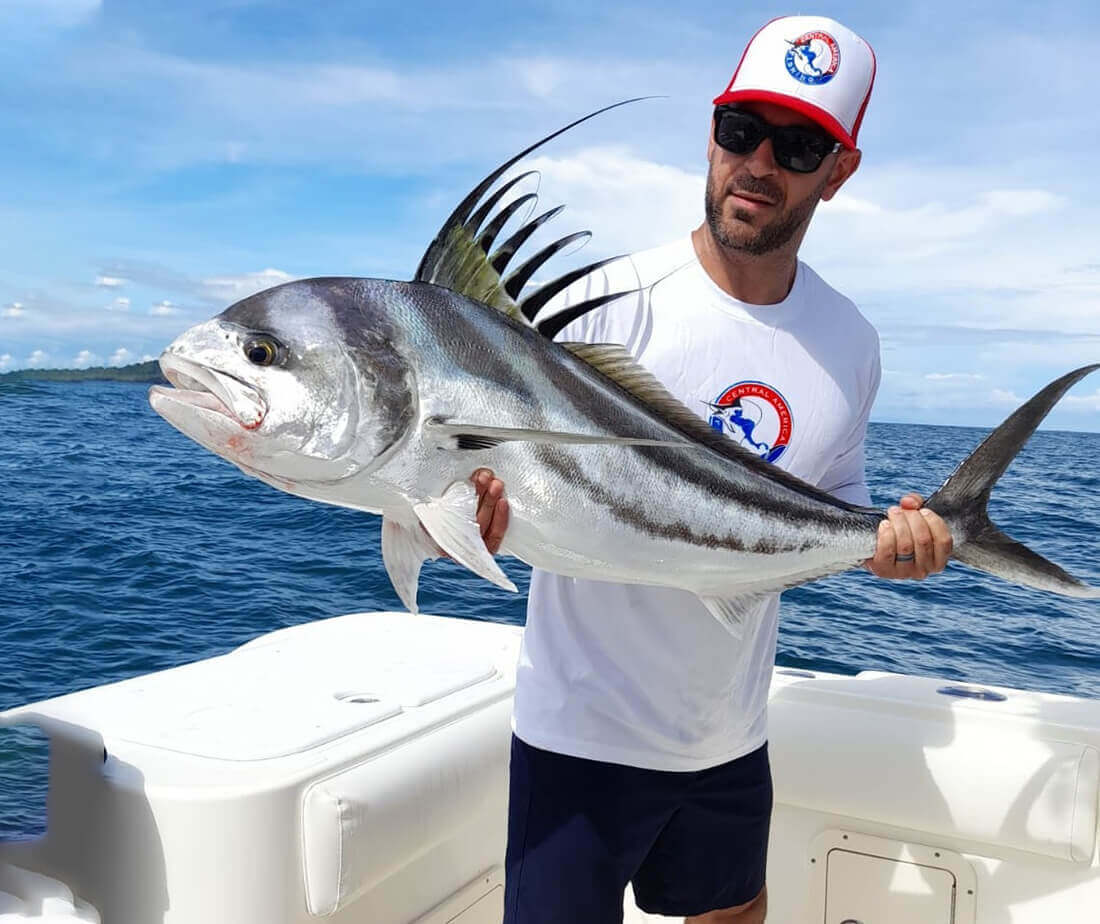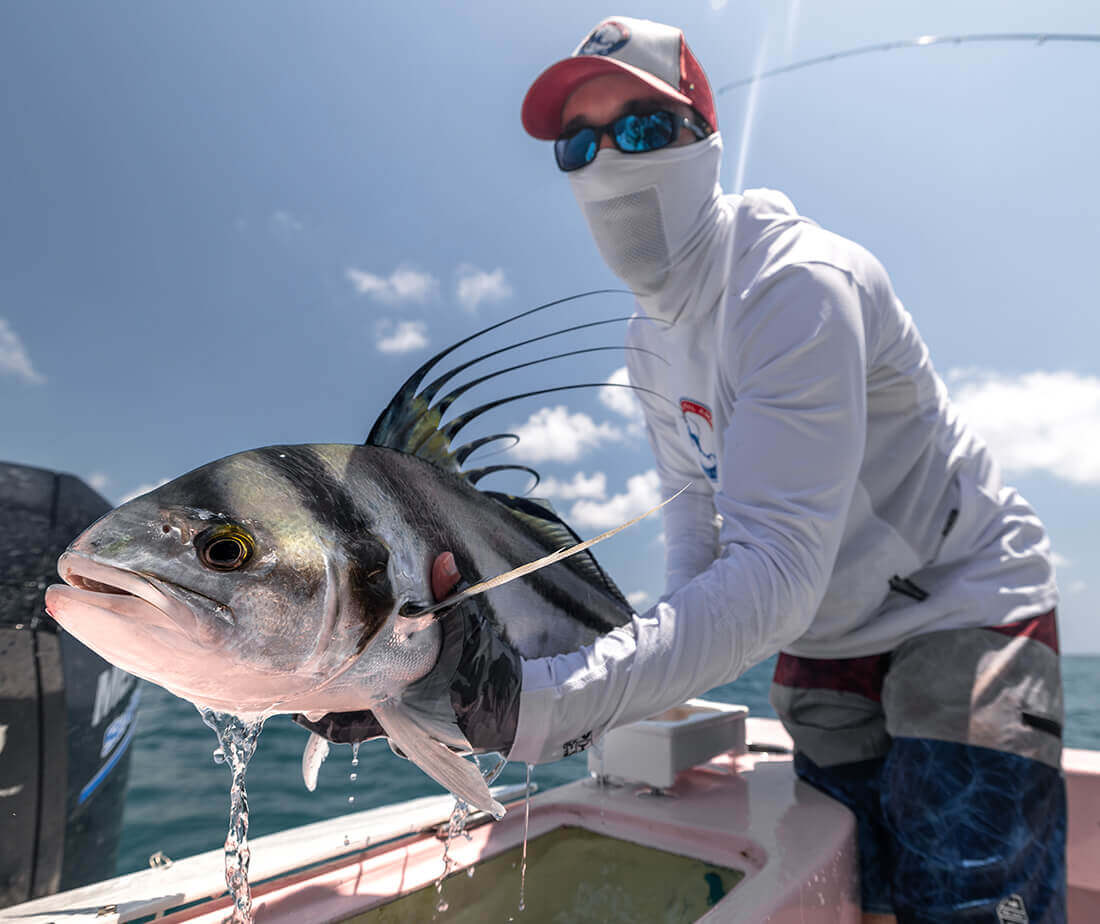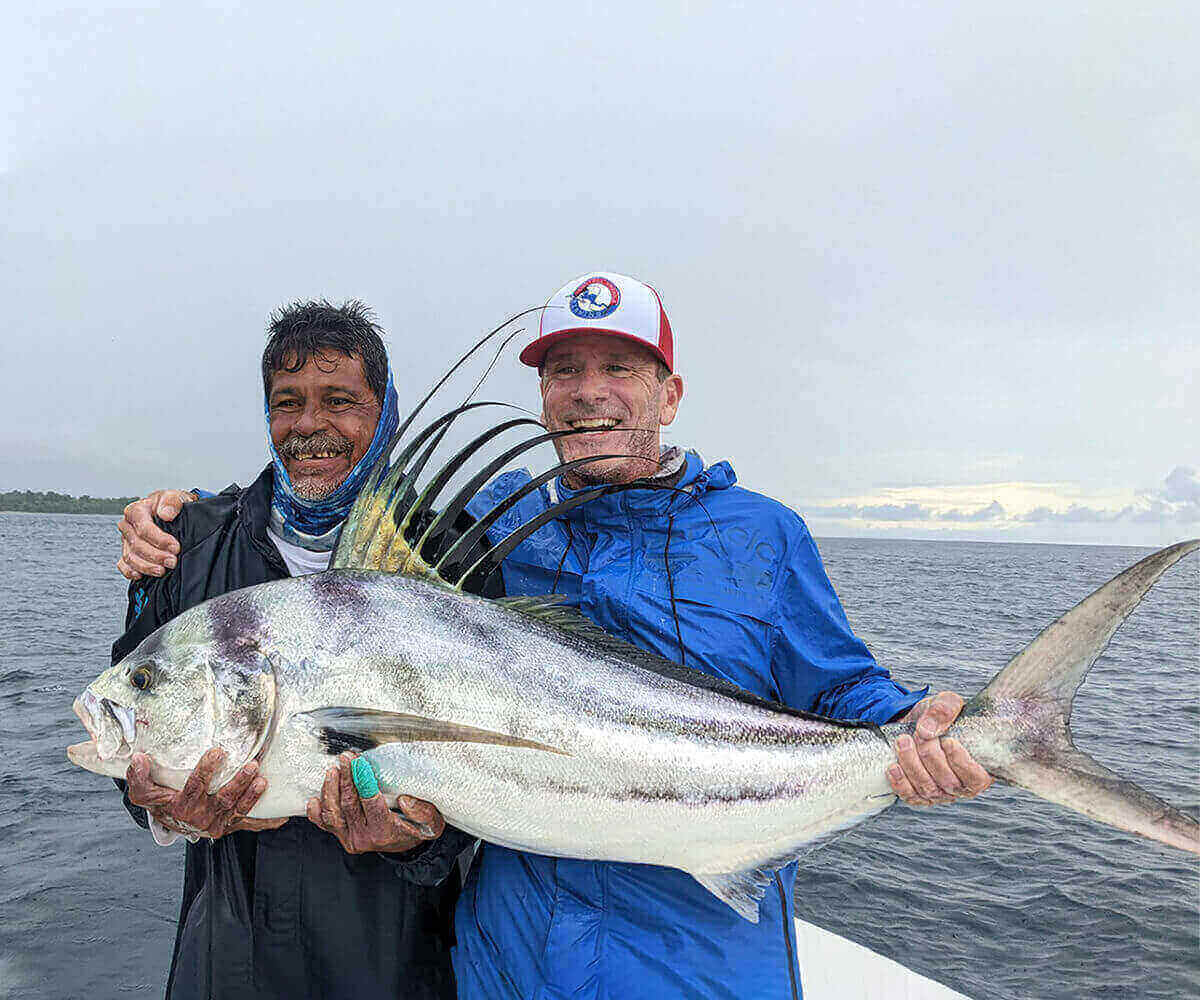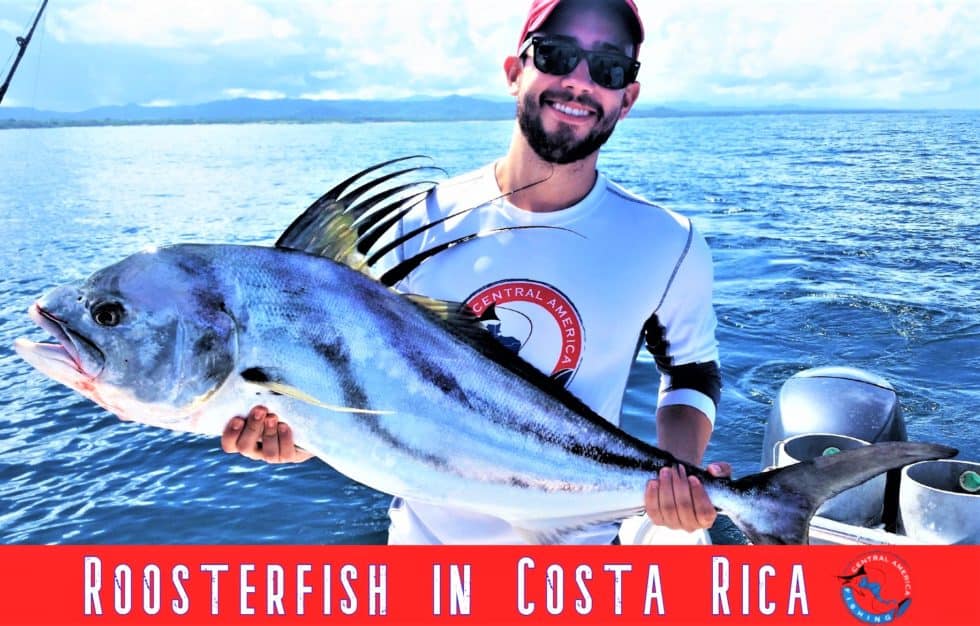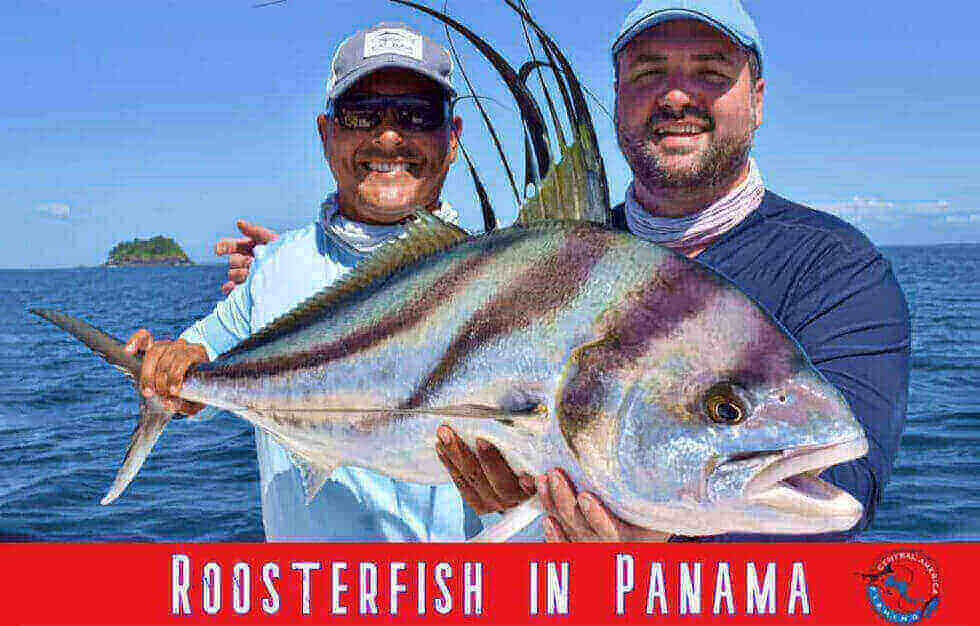Roosterfish
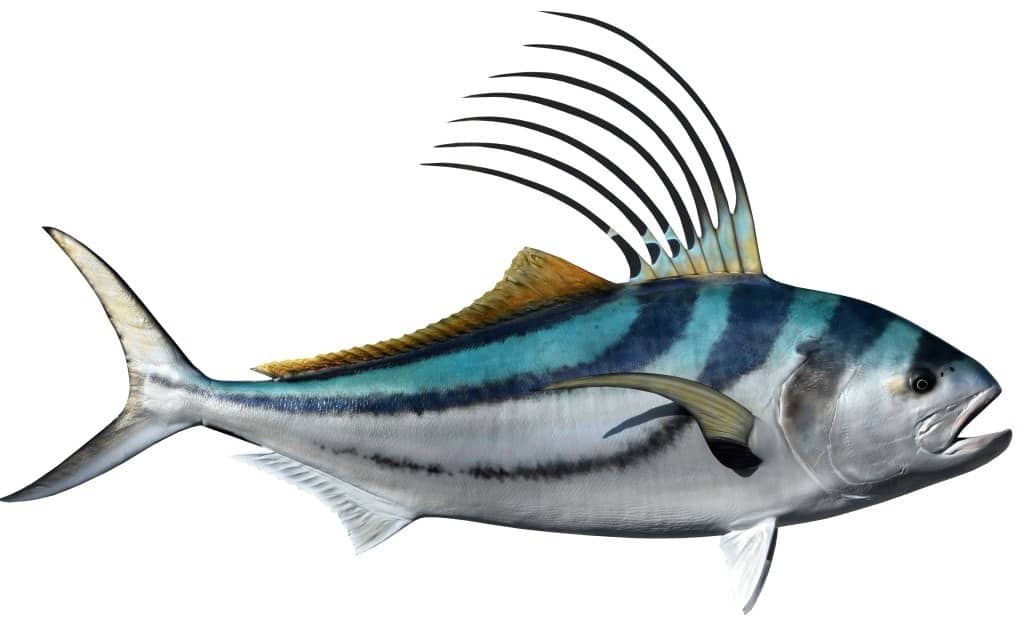
Anglers from across the globe visit Central America to try and catch roosterfish as they are one of the most sought-after inshore game fish in the world. They are aggressive, possess incredible fighting power, and make for beautiful pictures. The only thing negative to say about them is that their dark red meat is not considered to be very tasty, but that is also a good thing as it motivates anglers to continue practicing catch-and-release of this prized gamefish. When hooked, roosterfish usually don’t take to the air but prefer long, powerful runs. Often times when you think you have this inshore bruiser beat it will see the boat for the first time and take off on another scorching run peeling off all that hard-fought line you just gained on him. Read on and we’ll tell you when, where and how to catch roosterfish here in Central America.
It would be stating the obvious to say that the defining characteristic of the roosterfish is their unique dorsal fin. Made up of seven spines, it resembles the comb of a rooster and is how they got their name in both languages (they are called ‘pez gallo’ in Spanish). The majority of the time the dorsal fin remains at rest in a deep groove along the top of the rooster’s back, but when excited it will raise it to appear larger and help herd bait fish they are after. Roosterfish feature two dark, wide stripes diagonally along their flanks and another that runs along their sides to the base of the tail. These bands range in color from dark blue to purple to black which add to it’s beauty in pictures. Roosterfish are also very unique in that their swim bladder makes contact with their inner ear, which enhances their ability to hear. They are the only known fish to have this feature.
Most roosterfish in Central America are in the 20-40 lb range, but several times a year we trophy fish that weigh well over 50 lbs. By law roosterfish in Central America are not catch and release and locals will eat them occasionally, but 99% of roosterfish we catch on sport fishing charters we release to be caught another day.
What Do Roosterfish Eat?
How to Catch A Roosterfish
Live Bait
Any captain here will tell you that the best way to catch roosterfish in Central America is with live bait. The tried-and-true method is slow trolling with live bait like blue runners, sometimes sardines, and their favorite – lookdowns. When aiming for giant roosterfish, small bonito slow trolled around the rocky islands and reefs that they patrol can elicit bites from the 50+ pounders.
Topwater Lures
For many anglers, catching a roosterfish on a topwater lure is a dream come true. Seeing their iconic comb-like dorsal fin appear behind your popper and their erratic behavior will get anyone’s heart pumping. Some of our favorite lures for catching roosterfish are Yo Zuri bull popper, Halco Roosta poppers, and Chug Norris poppers. Color patterns that mimic their natural prey of flying fish, blue runners, sardines, and bonito are good ideas. The popular spook lures can also tempt a rooster to leave the rocks and hit at the surface. One of our personal favorites is the ranger lure. Due to its erratic surface action and how it skips from wave to wave, on the right day we’ve seen it drive roosters absolutely berserk.
Swimbaits
If you don’t have live bait and the roosterfish aren’t hitting the surface lures, the next best option is to start working swimbaits. While everyone dreams of catching a rooster on a surface lure, there are days when it simply isn’t going to happen, so having a swimbait that can work a little deeper in the water column can make all the difference of you going home empty handed or with a huge smile on your face. Roosterfish are known to patrol their home reefs and rockpiles, so something like a Yo Zuri crystal minnow or hydro minnow can be the perfect lure on the right day. Blacks, blues, silvers, and Central America classic of white with a red head are always favorites.
Jigging
While most anglers don’t think of roosterfish as a species you jig for, we’ve seen too many caught on jigs in our twenty years in Central America to rule this out. To be fair, a lot of the roosterfish caught on jigs were wonderful surprises as opposed to a dialed in attack, but it can be the winning formula on slow days. Roosterfish are notorious for not liking green water, so sometimes during our rainy season the top of the water column will have green water sitting on top, but 30-50 ft down it may be clear blue water. In these conditions, the roosterfish may be patrolling right at the thermal cline and hunting more on vibrations versus sight. If you can work a well-placed jig in front of a hungry roosterfish, hold on tight.
Fly Fishing
Without a doubt, roosterfish are one of the hardest fish to catch on a fly rod – but that doesn’t stop anglers from trying! This is one of the most challenging and frustrating fish to catch because you are often blind casting to them from a moving boat. Another technique is to have one angler work a popper to try and lure them up to the surface, then the fly angler casts his fly to that same spot as a sort of “bait & switch” tactic. You will almost never be able to cast to the same fish twice, so it’s really about having the stars align when they need to. A 9 wt rod with a large arbor reel is needed.
Fish the Tides
Catching a roosterfish is often very tidal-dependent, so knowing the tides when fishing for roosterfish is key. Like many inshore species, roosterfish will be most active feeding on rising and falling tides. Fishing a full 8-9 hour day can sometimes come down to a flurry of action that lasts 30-60 minutes, so make sure you are in the right spot at the right time!
Any captain here will tell you that the best way to catch roosterfish in Central America is with live bait. The tried and true method is slow trolling with live bait like blue runners, lookdowns, and even small bonito around the rocky islands and reefs that they patrol.
For many anglers, the dream of catching a roosterfish on a topwater lure is too hard to pass up. Seeing their iconic comb-like dorsal fin appear behind your popper and their erratic behavior will get anyone’s heart pumping. Some of our favorite lures for catching roosterfish are Yo Zuri bull popper, Halco Roosta poppers, and Yo Zuri crystal minnows. Color patterns that mimic their natural prey of flying fish, blue runner, sardines, and bonito are good ideas.
What is the World Record Roosterfish?
The all tackle world record is a 114 lb 0 oz monster caught back in 1960 in La Paz, Mexico. The all tackle world record for length was caught in Panama as recently as December 2019 with a 136.0 cm behemoth. Several different line class world records were also set in Costa Rica and Panama.
Are Roosterfish Edible?
Roosterfish are not protected by law, so they are technically an edible fish. That said, they are one of the most prized gamefish we have in Central America, so the vast majority of them are released so they can grow and be caught again. Those conservation efforts are certainly aided by the fact that roosterfish have a dark, red meat so they don’t taste very good to begin with. Typically, the only roosterfish that are harvested are the ones who died in the fight, otherwise we go to great lengths to revive them and release them.
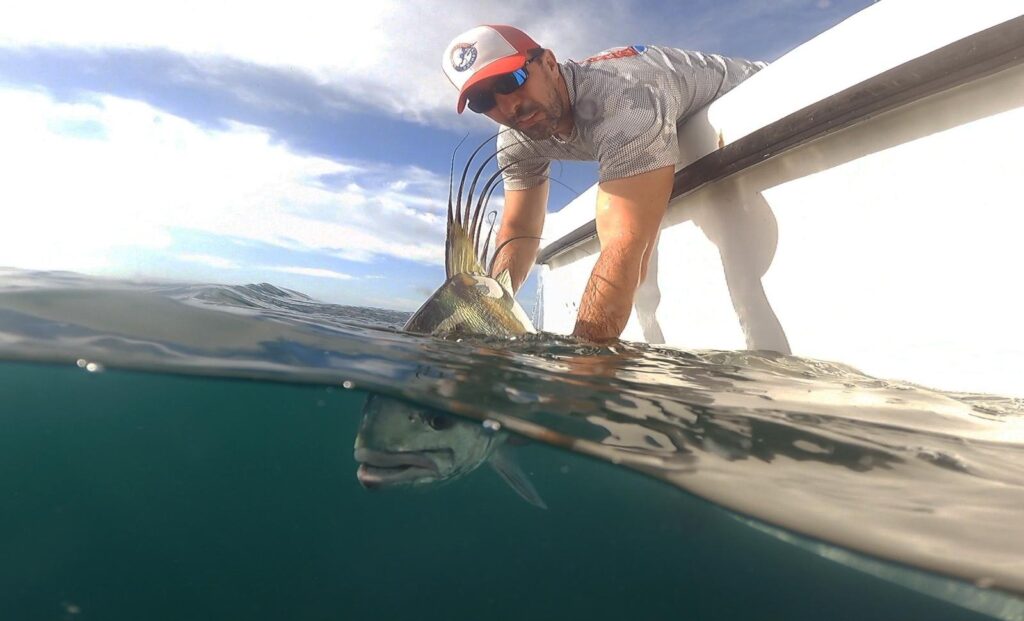
When is the Best Time to Catch Roosterfish?
Roosterfish are caught twelve months a year in Central America. Unlike pelagic species that are migratory and more seasonal, we catch roosterfish year round in Costa Rica and Panama. The most productive months for roosterfish are usually December through August, but the time of year you visit will determine where you should go to enjoy the best fishing. The dry season along the Pacific Coast is December through April, and that generally offers the best action as the water is clear blue and there are plenty of baitfish. At the start of the season in December we tend to see higher quantities of fish, but smaller sizes. It’s not uncommon to catch 10-20 roosterfish in a day in December, but many of those fish will be under twenty pounds. The all-time CAF record was set by the Johnson family who caught 34 roosterfish in one day in January 2024 fishing in Quepos, Costa Rica.
Big trophy roosters over 50 lbs can be caught any time of year, but that seems to happen more from Feb-to July. The months of September and October can be much slower for roosterfish because that is the peak of the rainy season in Central America. During this time of year, the rivers are dumping out tons of freshwater so the coastal waters turn green and are much cooler, which usually drives most of the roosterfish away.
Where is the Best Place to Catch Roosterfish?
Roosterfish are unique in that they are only found in the warm Eastern Pacific waters. Their range is from southern California to Peru, but their numbers are most prevalent here in Central America. Roosterfish are caught in the surf and over sandy bottoms, but they really seem to love rocky islands and reefs the most. They can also be caught near river mouths if bait is present, though they are not typically seen in brackish water like snook. Roosterfish are not migratory, typically they travel less than 300 miles in their lifetime, so good catch and release practices will ensure their survival and a long lasting bite for years to come. Two of the best countries in the world to catch them are right here in Costa Rica and Panama thanks to the combination of rocky islands and reefs, river mouths, and plentiful baitfish. While our boats in Guatemala and El Salvador also catch roosterfish, their numbers are not as consistently productive as Costa Rica or Panama.
